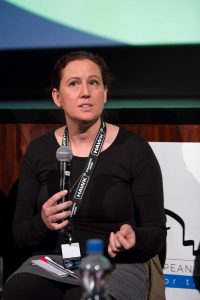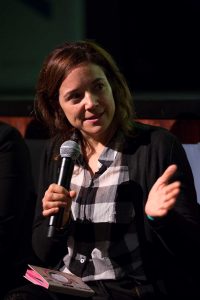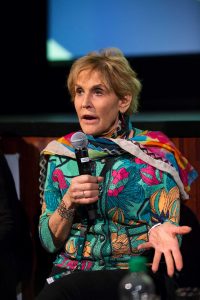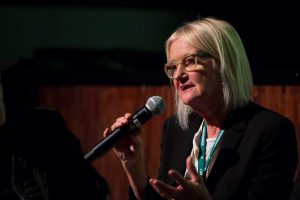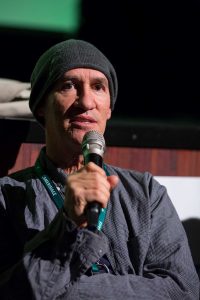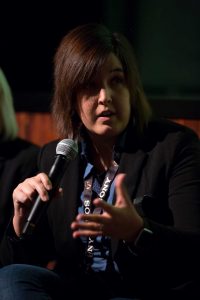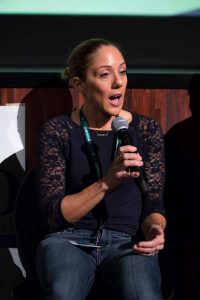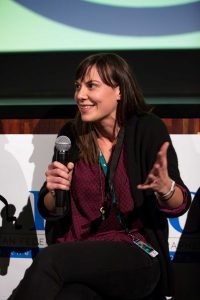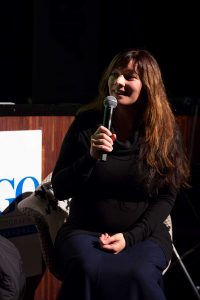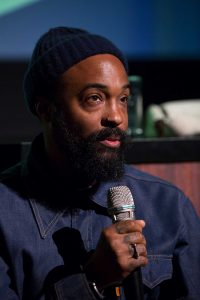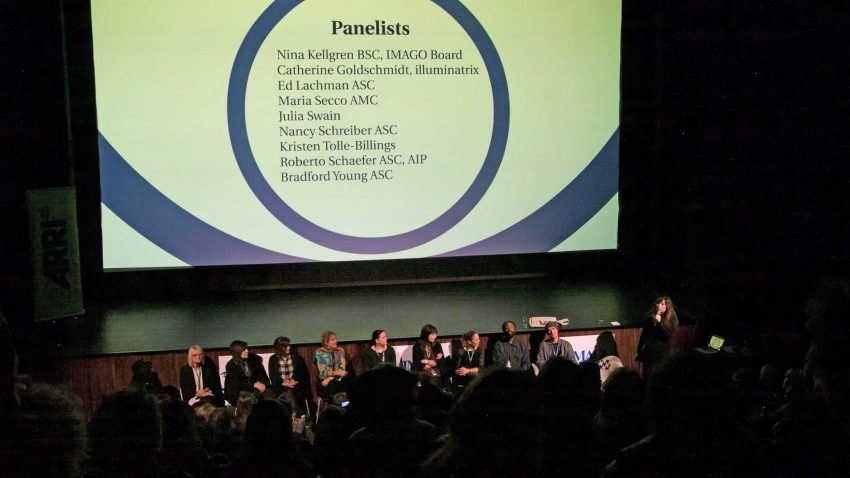
by Madelyn Most, November 25, 2016
“If you can see it, you can be it”
Forum on Diversity in Cinematography at Camerimage Festival, Bydgoszcz, Poland
Super Friday: what better way to wrap up an invigorating week immersed in all things cinematographic than to have an entire day devoted to female cinematographers with screenings, workshops and master classes by women that culminated with an animated panel discussion on Gender and Diversity entitled “What Works”.
Friday November 18th began with the screening of “Neon Demon” photographed by Natasha Braier, ADF, and directed by Nicolas Winding Refn that was moderated by Claire Pijman, NSC. The controversial film created quite a stir when it premiered in the Main Competition at this year’s Cannes Film Festival. At the Master class that followed, Natasha Braier discussed her early films, her inspirations, and her working relationship with Refn.
She used clips from “Demon” to illustrate her lighting strategies, and to show how vibrant colors were used to intensify the drama. “Bold and vigorous cinematography”…the film is “so beautifully made” with “mesmerizing shots that are exquisitely composed” …the photography “carries the bulk of the film” is what the critics said. Bravo Natasha.
Mid afternoon VR film director, cinematographer and stereographer Jannicke Mikkelson presented a workshop where she demonstrated the film rig she designed and constructed for the first 3D 360 degree Virtual Reality concert ever filmed, Queen’s 2014 concert in Barcelona called “VR The Champions”. The rig held 20 cameras that travelled on a four-point wire flying above the musicians and the audience to film the 3D VR concert. After the presentation, the audience put on virtual reality headsets and experienced the concert themselves.
That evening, for the first time ever, Camerimage, the festival of cinematography, IMAGO, the European Federation of Cinematographers, and illuminatrix, a U.K. collective of female cinematographers, hosted a forum on gender and diversity in cinematography. The panelists discussed what made their career work, while questioning the myths, inequalities, and obstacles that still exist in their respective countries.
Panel members included Nina Kellgren BSC, Maria Secco AMC, Nancy Schreiber, ASC, Julia Swain, cinematographer and director of “Women of Light”, Catherine Goldschmidt and Vanessa Whyte from illuminatrix, Velinda Wardell, ACS, WPA agent Kristen Tolle-Billings, Roberto Schaefer ASC, AIC, Ed Lachman, ASC, and Bradford Young, ASC, with Elen Lotman, President of the Estonian Society of Cinematography moderating. Also attending were Jannicke Mikkelson, Kirsten Johnson, Hilda Mercado, AMC, Natasha Braier, ADF, and Nigel Walters, BSC.
Elen Lotman ESC skillfully kept things upbeat and amusing.
She announced that the two hour symposium would be ‘positive, inspirational, and practical’ but “We are not going to solve these problems today. We are going to focus on things we can change ourselves”. Looking up at her slides on the screen, she said “ but the numbers don’t look good”.
Recent studies reveal that on feature film productions in the UK, women cinematographers make up less than 7%, and in the U.S. on the top 250 films, the number of women cinematographers is 5% .
Esteemed Director of Photography Nancy Schreiber ASC, shirking off the label of “trailblazer”, is a semi-permanent delegate on Camerimage juries, she is a role model for cinematographers around the world. Schreiber says there is a cultural bias against women. She debunks the notion that women lack experience and that the cameras are too heavy for them to hand- hold. …’Countless women directors and cinematographers are out there with varying levels of experience- they don’t need mentoring or workshops- they just need to be hired. There are obvious disparities between women with experience and successful track records and first time (often mediocre) male filmmakers who are given a shot at working on any number of movies including high budget blockbusters’, writes Scott Mendelson in his Forbes magazine piece, entitled “Female Directors don’t need to get Experience, they just need to get hired! “.
Other factors hampering their careers is the prejudice women
face when they are pregnant; as childcare is not available in the U.S., it might be a long time before they return to work. Ageism is another factor Schreiber rejects: some say work becomes scarce when women get past the age of fifty, others say it was the best years of their careers. (Remember, Haskell Wexler was in the process of making 3 films when he passed away in January, at age 94). Schreiber mentioned the incredible energy and vitaliy at the ‘Day of Inspiration’ that was held at the ASC clubhouse with over 140 women and men celebrating women cinematographers.
“If you have the passion, you’re just gonna do it. You’ll find people to work with,” beams Schreiber.
As an agent, Kristen Tolle-Billings suggests more young women start in music videos to hook up with young directors and then transition into commercials, which is a steppingstone to films. Kristen acknowledged that agencies have final say over the director when choosing cinematographers. When she put forward women for a job, they do tend to choose males, but it is getting somewhat easier these days for women to break through. Women have been receiving awards for their music video, commercial, and dramatic work which has helped. Exposure, Recognition, and Visibility are three important aspects for a successful career.
Illuminatrix, one of the organizers of this event, is a UK association of professional women cinematographers who work internationally on documentaries, commercials, television, and feature films. It was founded by cinematographers Catherine Goldschmidt and Vanessa Whyte who explain that the collective evolved from informal meetings in a pub to discuss work issues into an association of (29 at present) experienced cinematographers.
Nina Kellgren stressed the importance of doing enough work to join the cinematographic societies and associations because they are prestigious and bring recognition and respect when your name appears with those letters added on. “Take risks” she says, “if you are offered a job, just accept it, even if you don’t think you know technically how to do it- Just accept the job, there is plenty of support from great people at Arri, Panavision and other companies.”
Mentioning that women are prone to the “Imposter Syndrome”, (the feeling that you do not deserve the opportunity when given it) the audience burst out laughing when the much admired Roberto Schaefer ASC, AIC confessed he also is susceptible to this affliction. “After a producer announces I got the job…a little voice inside my head says, “You hired ME? Are you SURE?” Roberto’s international career is solid, so he can admit to nagging doubts and personal insecurities…..
Uruguayan Maria Secco AMC, who works in Mexico says it has gotten better but out of 140 movies produced last year, of which 70% were supported by the state, less than 8 % were photographed by women. “When I am shooting, I feel I am treated the same, I don’t think my role as cinematographer is different because of my gender.” In the last 3 years, the Mexican Academy awarded 2 women with the prestigious cinematography award and she was one of them.
It is disturbing that women are largely left out of the nominations and the awards… “Awards are important, finding role models is important, surrounding oneself with supportive men is important, but most of all I believe it’s all about visibility and getting the opportunities. Just being out there doing the job and being the best that you can be is important” says Katie Goldschmidt. Velinda Wardell ACS added, “Submitting your films to festivals, being in the program, attending festivals, and being active are ways to be recognized…that was my experience in Australia”.
Ed Lachman made a disclaimer saying although he looked like a white male, it was his feminine side that was participating in the panel. He said he has better working relationships with women directors because there is less of an ego problem, while Bradford Young says it was women (99% of the time) who hired him. Roberto Schaefer said as a white male in L.A., he faces intense competition for a job, but ironically, foreigners are perceived as ‘exotic’ and they have a better chance of being hired.
The atmosphere turned more serious when the charismatic soft-spoken Bradford Young ASC, took the microphone. “I consider myself a black cinematographer, my art is my struggle, my struggle is human rights. Opportunity makes you feel empowered, you feel better about yourself. It takes a certain level of fortitude to do what we do because we are holding up so much…. but there is prejudice on the set, there is bias. I can hear things, I can feel it in the air…. So when you see these things happening on the set, it’s your duty to stop it, SHUT IT DOWN- -quickly and publicly.”
Recently we have seen films with images reinforcing black stereotypes- “Birth of a Nation”, “Beast of the Southern Wild” and others.… we must take responsibility for that .
The burst of applause stopped abruptly when Kirsten Johnson, (cinematographer and Director of “Cameraperson”) spoke up….
“I want to support what Bradford says. We are standing on a history of misrepresentation. I went back into the footage I shot over the last 25 years working on human rights films…I didn’t understand the way I was representing people.…Our blind spots are stupefying. We, the image-makers, are culpable and we must own this- we are responsible for the images we put out in the world. For instance, the way we portray (human beings in a war zone) as victims rather than loving parents. It is doing them harm in the moment, and it is doing the world harm. We are being asked to make the strongest images…violence is strong, bodies being killed is strong, we regularly see images of an incompetent girl and a fighting boy. We are up against structural injustice. No matter what we look like, WE have to question every image we make in order to shift the way that people see. What we film is telling the story of what we believe in” Johnson concluded, to a noisy ovation.
The forum ended with Julia Swain presenting a ten minute teaser of her documentary film, “Women of Light” that was funded through Kickstarter. The film highlights many of today’s leading cinematographers from around the world, as well as some of the pioneers who look back on their early careers revealing the challenges and difficulties they had to overcome from colleagues, from the industry, and from the (labour) union. They discuss what being a cinematographer means to them today. There is an impressive montage of footage at the end, something like a collective showreel, with scenes from the wonderful films they have photographed.
“The media says there are very few women cinematographers, but there are so many incredible women shooting, and I am so excited to have been able to put their stories on the screen in “Women of Light”. It’s time we honor women in film and honor women in cinematography around the world to inspire future generations” says Swain.
The conference slowly came to a close. With all the applause, cheers, laughter, excitement, and enthusiasm, a sense of bonding emerged among the audience- a feeling they would support each other, continue to push the barriers and break the glass ceiling. It was an historical day of encouragement and inspiration that laid the foundation for on-going conversations at future forums.
In a closing statement, Catherine Goldschmidt and Vanessa Whyte, co-founders of illuminatrix said:
“As co-organisers of the Diversity Panel at Camerimage, along with Nina Kellgren BSC and Elen Lotman ESC at IMAGO, we were absolutely delighted to participate in such an energized and motivating event. Listening to this diverse group of cinematographers from all over the world was incredibly inspiring and we were so heartened to hear such passionate contributions from the audience; from film students to professional cinematographers at the top of their game. The greatest takeaway was that there is a huge appetite for more diverse stories from a more diverse group of film makers, and that as individuals we all have the power to be change-makers. It’s no longer time to sit back and wait for the industry to level out, it’s time for each of us to make positive changes within our own circle of influence, and those circles can grow and bloom, and finally merge with those of others to eventually build a more fair and diverse cinema.”
Photos below by Phil Erbacher
- Velinda Wardell ACS
- Maria Secco AMC
- Nancy Schreiber ASC
- Nina Kellgren BSC
- Roberto Schaefer, ASC, AIC
- Elen Lotman ESC
- Julia Swain
- Kristen Tolle-Billings
- Catherine Goldschmidt
- Ed Lachman ASC
- Elen Lotman ESC
- Bradford Young ASC

